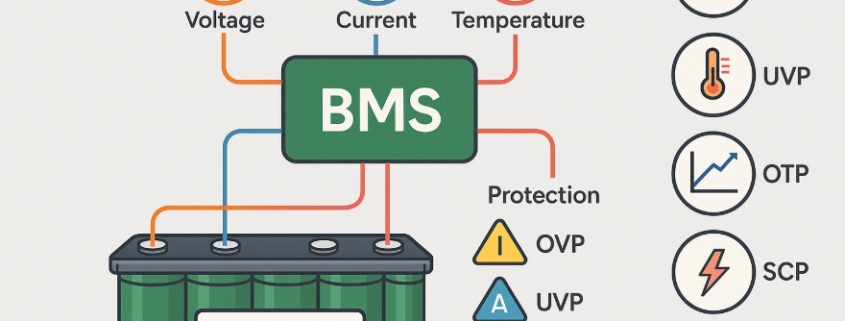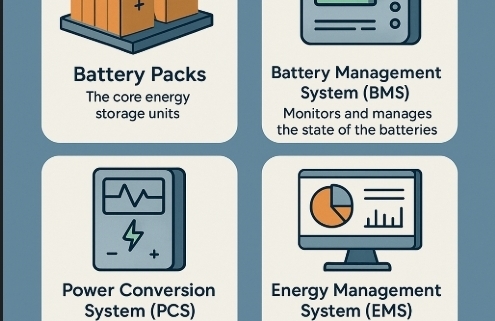🛠️ BMS Explained: Real-Time Monitoring, Key Protections, and SOC/SOH Algorithms
In the age of electric vehicles, solar energy storage, and portable power, batteries are everywhere. However, they don’t work efficiently—or safely—on their own. That’s where the Battery Management System (BMS) steps in.
A BMS monitors, protects, and optimizes battery operation. In this guide, we’ll break down how a BMS works, what makes it essential, and how it improves battery safety and performance.
Let’s begin with the basics.
🔍 What Is a BMS (Battery Management System)?
A Battery Management System (BMS) is an electronic controller found in nearly every advanced battery pack. Whether in electric scooters or solar home systems, the BMS performs several important tasks:
- It monitors battery health and performance.
- It protects the battery from unsafe conditions.
- It balances cells to maintain consistency.
- It calculates key values like State of Charge (SOC) and State of Health (SOH).
- It communicates with other devices and controllers.
In short, it acts as the brain behind the battery.
📈 BMS Real-Time Monitoring: Constant Awareness, Constant Safety
At the heart of every BMS is real-time monitoring. This feature continuously checks the condition of the battery, ensuring it remains within safe and efficient operating limits.
Here’s what it tracks:
🔋 Voltage Monitoring
Each battery cell has a safe voltage range. The BMS monitors individual cell voltages and the total pack voltage. Even a small voltage imbalance can reduce performance or cause damage.
➡️ Why it matters: It helps avoid overcharging or over-discharging, which can permanently damage cells.
⚡ Current Monitoring
By measuring the charging and discharging current, the BMS keeps track of how much energy is moving in or out of the battery.
➡️ Why it matters: It prevents dangerous current spikes and helps calculate the battery’s remaining energy.
🌡️ Temperature Monitoring
Battery temperature is closely watched using thermal sensors. Too much heat or cold can cause big problems.
➡️ Why it matters: If a battery gets too hot, it can overheat or even catch fire. Monitoring temperature helps avoid this.
🛡️ BMS Protection Features: Preventing Damage Before It Happens
Real-time monitoring is helpful, but monitoring alone isn’t enough. The BMS also responds when things go wrong. It includes four core protection mechanisms, each with a specific safety role.
1. ✅ Over Voltage Protection (OVP)
If a battery is charged beyond its safe limit, chemical reactions inside the cells can become unstable.
➡️ Why it matters: OVP prevents this by stopping charging when voltage gets too high. This protects the cells and keeps them from overheating.
2. ❌ Under Voltage Protection (UVP)
If voltage drops too low during discharge, cells can be permanently damaged.
➡️ Why it matters: UVP shuts down the battery before damage occurs. It helps protect capacity and extends battery life.
3. 🌡️ Over Temperature Protection (OTP)
Charging or discharging at extreme temperatures can harm the battery.
➡️ Why it matters: OTP stops activity when the battery is too hot or cold. This ensures safe operation in every condition.
4. ⚠️ Short Circuit Protection (SCP)
If a short circuit occurs, current can spike instantly. This can lead to fire or explosion.
➡️ Why it matters: SCP reacts in microseconds to cut off power, preventing serious accidents.
⛽️ State of Charge (SOC): How Much Energy Is Left?
Think of SOC as the battery’s fuel gauge. It tells you how much usable energy remains, usually shown as a percentage (like 75% or 50%).
How SOC is calculated:
- Coulomb counting: Tracks how much current flows in and out.
- Voltage-based estimation: Uses resting voltage as an indicator.
- Temperature-corrected models: Account for heat effects on performance.
➡️ Why it matters: Knowing SOC helps you avoid running out of battery unexpectedly. It also prevents overcharging, which protects the battery.
🧬 State of Health (SOH): Is the Battery Aging?
While SOC tells you the current charge, SOH tells you how healthy the battery is overall. It measures how much the battery has degraded over time.
SOH is based on:
- Charge capacity fade
- Internal resistance increase
- Temperature behavior over time
- Number of charging cycles
➡️ Why it matters: A battery may charge fully but still not perform like new. SOH lets users know when a battery is aging or needs replacement. It’s also useful for warranties and service checks.
⚖️ Cell Balancing: Keeping Every Cell in Sync
While monitoring and protection are essential, a truly effective Battery Management System also performs cell balancing. This function ensures that all individual cells within the battery pack maintain equal voltage levels.
Over time, slight differences in cell chemistry, resistance, or temperature cause some cells to charge faster or slower than others. Left unchecked, this leads to performance drops and early aging.
📌 What Is Cell Balancing?
Cell balancing equalizes the voltage of each cell, improving pack efficiency and lifespan.
There are two main types:
1. 🔋 Passive Balancing
In passive balancing, extra energy from higher-voltage cells is burned off as heat using resistors.
- ✅ Simple and low-cost
- ✅ Common in consumer electronics
- ❌ Less efficient due to energy loss
2. ⚡ Active Balancing
Active balancing redistributes charge from more charged cells to less charged ones, using inductors, capacitors, or switch networks.
- ✅ Higher efficiency
- ✅ Extends battery life
- ✅ Suitable for EVs, BESS, drones
- ❌ More complex and expensive
🧠 Why Balancing Matters
Balancing is critical because even small voltage mismatches between cells can lead to:
- Uneven charging
- Reduced usable capacity
- Early triggering of safety cutoffs
- Accelerated aging in weaker cells
By balancing cells, the BMS ensures every cell contributes equally—maximizing safety, performance, and battery lifespan.
⚙️ Where BMS Is Used
You’ll find BMS systems in many places, including:
🚗 Electric Vehicles
- Manages high-voltage battery packs
- Ensures safe fast charging
- Controls thermal systems for safety and performance
☀️ Solar Energy Storage
- Regulates battery banks for homes and businesses
- Prevents overcharging from solar input
- Ensures reliable power at night or during outages
📱 Portable Devices
- Protects battery in phones and laptops
- Extends device life and charge cycles
- Ensures safety during fast charging
🧠 Final Thoughts: Why Every Battery Needs a BMS
Batteries are powerful, but they are also sensitive. Without a Battery Management System, they would fail faster—and sometimes dangerously. With features like:
- Real-time monitoring
- Over-voltage, under-voltage, temperature, and short-circuit protections
- SOC and SOH calculations
- Cell balancing for efficiency and safety
…a BMS ensures that the battery stays safe, efficient, and long-lasting.
If you’re using or building battery-powered systems, never ignore the importance of a well-designed BMS. It’s the hidden engine behind every reliable energy solution.
🤛 BMS Frequently Asked Questions
Q1: Can I use batteries without a BMS?
➡️ Technically yes, but it’s risky. A BMS prevents overheating, damage, and accidents.
Q2: What type of batteries use a BMS?
➡️ Mostly lithium-based batteries (like Li-ion or LiFePO4), but other chemistries can also benefit.
Q3: Can a BMS extend battery life?
➡️ Absolutely. By balancing cells, protecting from damage, and avoiding extreme conditions, a BMS helps batteries last longer.
Q4: How accurate is the SOC reading?
➡️ Accuracy depends on the BMS algorithm, temperature conditions, and battery type. Premium systems can be highly precise.



